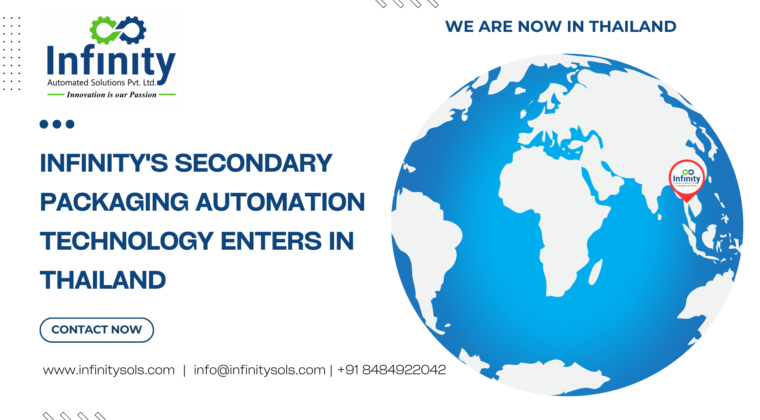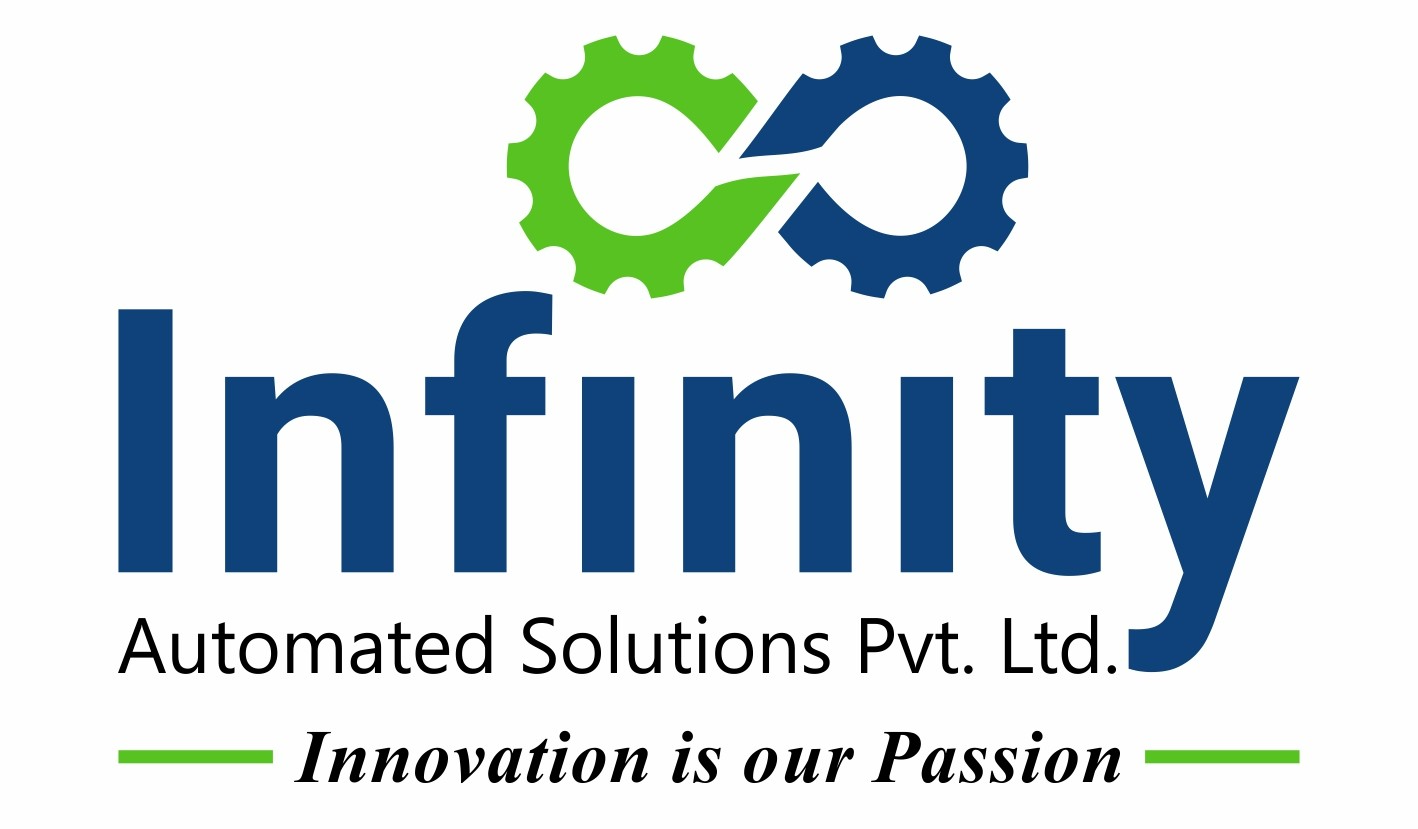Infinity Automated Solutions, a global leader in innovative automation solutions, has announced the successful project collaboration of its state-of-the-art Secondary Packaging Automation Technology in Thailand. The implementation marks a significant milestone of its Secondary Packaging Automation in the industry, promising enhanced efficiency, eliminating manpower & providing the complete packaging process on one single line.
The Secondary Packaging Automation Technology is a revolutionary system designed to streamline the secondary packaging processes in various industries, including food and beverage, pharmaceuticals, consumer goods, and more. By integrating advanced robotics, artificial intelligence, and machine learning algorithms, Infinity’s technology offers unparalleled performance in secondary packaging tasks.
Infinity Grabs Biggest Project in Thailand for “Secondary Packaging Automation Technology”
Mr. Amit Katariya, MD of Infinity Automated Solutions, expressed his excitement about the company’s latest venture into the Southeast Asian market. He said, “We are delighted to introduce our Secondary Packaging Automation Technology to Thailand. This cutting-edge solution is engineered to not only optimize packaging operations but also to bring a competitive edge to local businesses, enhancing their overall productivity and growth prospects.”
The new technology by Infinity boasts several key features that set it apart from traditional packaging methods. The system offers highly adaptable packaging solutions, capable of handling a wide range of products with precision and speed. Additionally, its intuitive user interface allows for easy programming and monitoring, minimizing the need for extensive technical training.
One of the technology’s most significant advantages is its ability to reduce packaging errors and material wastage. By employing smart sensors and vision systems, the automation technology ensures precise packaging, reducing product damage during the process. This not only positively impacts a company’s bottom line but also contributes to sustainability efforts by cutting down on unnecessary waste.
With the successful deployment of the Secondary Packaging Automation Technology in Thailand, Infinity continues to solidify its position as a key player in the automation industry. As the company expands its global footprint, it is expected to bring innovation and technological advancements to diverse sectors worldwide.
As Thailand accelerates toward a future driven by automation, Infinity’s Secondary Packaging Technology is likely to be a cornerstone in revolutionizing the way products are packaged, delivered, and consumed in the country and beyond.
Infinity’s Baler (IBL-500) Technology Helpful for Staple Food
Absolutely! Infinity’s baler technology can be immensely beneficial for staple food products. Staple foods are essential items that form the foundation of people’s diets and are consumed regularly in large quantities. These products include rice, wheat, flour, pulses, grains, and other similar items. Efficient and precise packaging of staple foods is crucial to ensure their quality, freshness, and longevity during storage and transportation.
Here’s how Infinity’s baler technology can enhance the packaging process for staple foods:
- Improved Efficiency: Automation technology can significantly increase the speed and efficiency of packaging operations. With advanced closed-loop systems and smart algorithms, the system can package staple foods quickly and consistently, reducing bottlenecks in the production line.
- Reduced Product Loss: The technology’s smart sensors and vision systems enable accurate and precise packaging, minimizing the risk of product damage during the process. This reduction in product loss can lead to cost savings for manufacturers and ultimately benefit consumers by keeping prices stable.
- Customizable Packaging: Staple foods come in various sizes and quantities, catering to different consumer needs. The automation system’s adaptability allows it to handle various packaging formats, making it ideal for different types of staple food products.
- Hygiene and Safety: Maintaining hygiene and food safety is of utmost importance in the food industry. The automated packaging process minimizes human contact with the products, reducing the risk of contamination and ensuring that staple foods reach consumers in optimal condition.
- Sustainability: This technology can help reduce packaging waste by precisely measuring and using the right amount of materials needed for each package. This aligns with sustainability goals and reduces the environmental impact of packaging operations.
- Scalability: As staple foods are produced and consumed on a large scale, the automation technology’s ability to handle high volumes ensures that packaging demands can be met efficiently, even during peak production periods.
- Consistency and Brand Image: The automated process ensures uniform packaging across all products, reinforcing brand identity and building trust among consumers.
IBL-500 Has the Flexibility to Handle Different Product Variants
Handling different product variants is a crucial aspect of any secondary packaging automation system, especially in industries that produce a wide range of products with varying sizes, shapes, and packaging requirements. Ensuring that automation technology can efficiently adapt to these different product variants is essential to maintain productivity, accuracy, and flexibility in the packaging process.
Here are some key considerations for successfully handling different product variants with a secondary packaging automation system:
- Versatile Gripping Mechanisms: The automation system should have adaptable gripping mechanisms or end-of-arm tools (EOATs) that can securely handle various product shapes and sizes without causing damage. Grippers that can adjust their shape or grip pressure based on the product’s characteristics ensure a gentle and efficient handling process.
- Adjustable Conveyor System: The conveyor system should be adjustable to accommodate different product sizes and shapes. The conveyor’s width, height, and speed may need to be altered depending on the specific product being packaged.
- Smart Vision Systems: Incorporating advanced vision systems equipped with machine learning capabilities allows the automation system to recognize and adapt to different product variants accurately. This enables the system to make real-time adjustments to the packaging process based on the product’s dimensions and positioning.
- Product Changeover: Efficient product changeover is essential for minimizing downtime and maximizing productivity. The automation system should be designed to facilitate quick and easy transitions between different product variants without the need for extensive reconfiguration.
- Programmable Logic Controllers (PLCs): PLCs play a crucial role in automation systems, allowing for easy reprogramming and adjustment of parameters for different product variants. This flexibility ensures the seamless integration of new products into the packaging process.
- User-Friendly Interface: The automation system should have an intuitive and user-friendly interface that simplifies the setup and adjustment process for different product variants. This empowers operators to efficiently manage product changeovers and reduce the risk of errors.
- Modular Design: A modular design approach allows for scalability and customization of the automation system to accommodate future product variants or changes in packaging requirements.
- Quality Control Mechanisms: Implementing quality control checks at various stages of the packaging process ensures that the correct product variant is being handled and packaged accurately.
- Testing and Validation: Rigorous testing and validation processes are essential to ensure that the automation system performs flawlessly with different product variants before its full implementation in the production line.
Compact Design & Reduces Extensive Manpower
A compact design means the automation system takes up less floor space, which is especially valuable in manufacturing facilities with limited room. By utilizing the available space efficiently, businesses can maximize their production capacity and potentially allocate the saved space for other purposes.
By automating secondary packaging tasks, businesses can significantly reduce the need for extensive manpower. The expenses associated with hiring, training, and managing a large workforce are minimized, resulting in substantial cost savings in the long run.
Customers Save Huge Cost On Manpower
Implementing a secondary packaging automation system has proven to be a game-changing move for this customer, resulting in significant savings on manpower costs. By embracing advanced automation technology, the customer has experienced a transformation in their packaging operations, optimizing efficiency and streamlining processes. Here are some key factors that contributed to their substantial cost savings:
- Reduced Workforce: The automation system’s ability to handle various secondary packaging tasks has significantly decreased the need for manual labor. As a result, the customer was able to downsize their workforce, saving on salaries, benefits, and other associated labor costs.
- Increased Productivity: Automation systems can operate at a consistent pace without fatigue or breaks, leading to a substantial increase in productivity compared to human labor. The customer now enjoys higher output levels, allowing them to meet production targets more efficiently.
- Minimized Downtime: With automation, the need for breaks and rest periods is eliminated. The system runs continuously, minimizing downtime and maximizing production uptime. This continuous operation translates to enhanced overall efficiency and output.
- Faster Packaging Speed: The automation system’s rapid packaging speed enables the customer to package products at a much faster rate than with manual labor. This increased speed has accelerated the customer’s ability to fulfill orders and respond to market demands promptly.
- Consistent Quality: The automation system ensures consistency in the packaging process, leading to uniform and high-quality packaging for all products. This has positively impacted the customer’s brand image and customer satisfaction.
- Quick Changeovers: The automation system’s versatility allows for quick changeovers between different products or packaging formats. The customer can now adapt to varying customer demands with ease, reducing setup time and enhancing overall operational flexibility.
- Enhanced Safety: By automating repetitive and potentially hazardous tasks, the customer has improved workplace safety and reduced the risk of work-related injuries. This has resulted in cost savings related to worker health and safety measures.
- Optimization of Resources: Automation systems are designed to use resources efficiently, such as reducing material waste and optimizing energy consumption. This optimization has further contributed to cost savings for the customer.
- Real-time Data Insights: Automation systems often come equipped with data tracking and analytics capabilities, providing the customer with valuable insights into production metrics, process efficiency, and resource utilization. This data-driven approach allows the customer to make informed decisions to further optimize their operations.


